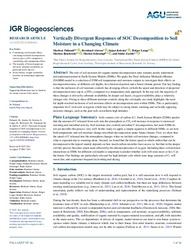Vertically Divergent Responses of SOC Decomposition to Soil Moisture in a Changing Climate
DOI: https://doi.org/10.1029/2021JG006684
Persistent URL: http://resolver.sub.uni-goettingen.de/purl?gldocs-11858/9864
Persistent URL: http://resolver.sub.uni-goettingen.de/purl?gldocs-11858/9864
Supplement: https://doi.org/10.5281/zenodo.5654554
Pallandt, Marleen; Ahrens, Bernhard; Koirala, Sujan; Lange, Holger; Reichstein, Markus; Schrumpf, Marion; Zaehle, Sönke, 2022: Vertically Divergent Responses of SOC Decomposition to Soil Moisture in a Changing Climate. In: Journal of Geophysical Research: Biogeosciences, Band 127, 2, DOI: 10.1029/2021JG006684.
 |
Dokument öffnen: |
The role of soil moisture for organic matter decomposition rates remains poorly understood and underrepresented in Earth System Models (ESMs). We apply the Dual Arrhenius Michaelis‐Menten (DAMM) model to a selection of ESM soil temperature and moisture outputs to investigate their effects on decomposition rates, at different soil depths, for a historical period and a future climate period. Our key finding is that the inclusion of soil moisture controls has diverging effects on both the speed and direction of projected decomposition rates (up to ±20%), compared to a temperature‐only approach. In the top soil, the majority of these changes is driven by substrate availability. In deeper soil layers, oxygen availability plays a relatively stronger role. Owing to these different moisture controls along the soil depth, our study highlights the need for depth‐resolved inclusion of soil moisture effects on decomposition rates within ESMs. This is particularly important for C‐rich soils in regions which may be subject to strong future warming and vertically opposing moisture changes, such as the peat soils at northern high latitudes. Plain Language Summary:
Soils contain a lot of carbon (C). Earth System Models (ESMs) predict that the amount of C released from soils into the atmosphere as CO2 will increase in response to increased warming and microbial activity. Soil moisture also controls microbial C decomposition, but most ESMs do not yet describe this process very well. In this study we apply a simple equation to different ESMs, to see how both temperature and soil moisture change microbial decomposition under future climate. First, we show that the speed of C released into the atmosphere changes when we include soil moisture changes, compared to what is expected due to warming alone. Second, we found that the future speed at which carbon that can be decomposed in the topsoil mainly depends on how much carbon microbes have access to, but that in the deeper soil this process becomes much more affected by the absence/presence of oxygen. Including these soil moisture interactions in ESMs for different soil depths is important to predict whether soils will store more or less C in the future. Our findings are particularly relevant for high latitude soils which store large amounts of C, will warm fast, and experience frequent (re)wetting and drying. Key Points:
Considering soil moisture effects can change modeled decomposition rates by up to ±20% compared to considering only temperature effects.
The majority of these changes are driven by substrate availability, in particular in the top soil.
In the subsoil, oxygen availability becomes an increasingly important factor.
Statistik:
ZugriffsstatistikSammlung:
Schlagworte:
decompositionsoil organic carbon
soil moisture
decomposition model
climate change
DAMM model
This is an open access article under the terms of the Creative Commons Attribution License, which permits use, distribution and reproduction in any medium, provided the original work is properly cited.

